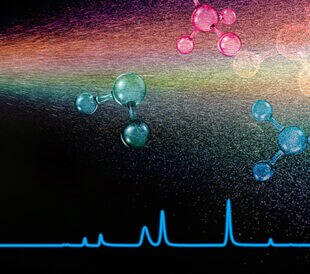Glycans play a pivotal role in determining the structure and function of biopharmaceutical proteins, with even small changes in glycan composition or location potentially affecting drug safety and efficacy. To ensure product quality and protect patient safety, accurate, reliable and convenient methods for glycoprotein characterization and glycoslyation profiling are therefore required.
Precision glycan profiling using dual eluent generation cartridge HPAE-PAD
High-performance anion-exchange (HPAE) chromatography coupled with pulsed amperometric detection (PAD) is a well-established carbohydrate analysis technique that is widely used for glycosylation profiling of glycoprotein therapeutics. Taking advantage of the weakly acidic nature of carbohydrates, HPAE chromatography uses strong anion-exchange column chemistries to achieve highly selective glycan separations at high pH. The use of PAD enables the direct quantification of analytes, avoiding the need for lengthy sample derivatization steps.
HPAE-PAD methods for carbohydrate analysis typically require the use of high-purity sodium hydroxide/sodium acetate eluents, which can be labor-intensive and time-consuming to prepare. To achieve high-quality results, particular care must be taken to minimize eluent contamination from dissolved carbon dioxide.
Fortunately, recent advances in reagent-free ion chromatography have led to faster and more convenient options for eluent preparation. Dual eluent generation cartridge (dual EGC) mode is a new operating approach for HPAE-PAD systems that replaces the use of hand-prepared sodium hydroxide/sodium acetate eluent gradients with electrolytically generated potassium hydroxide (KOH)/potassium methanesulfonate acid (KMSA) eluents. By generating eluents automatically, dual EGC mode operation ensures the consistent production of high-purity mobile phases, reducing system contamination and improving method precision and productivity.
Dual eluent generation cartridge HPAE-PAD improves reproducibility and convenience
Currently, the only platform to support dual EGC mode operation for the analysis of complex carbohydrates is the Thermo Scientific Dionex ICS-6000 HPIC system. Thanks to its advanced design, the system allows analysts to use methanesulfonic acid and KOH cartridges in series to electrolytically generate KOH/KMSA gradients of various concentrations and slopes using a single isocratic pump. The platform supports both capillary (0.4 mm) and analytical (1.0 mm) column formats, enabling this approach to be used for a wide range of carbohydrate analysis applications.
As dual EGC mode operation allows more accurate eluent concentrations to be used, the approach supports more consistent and reproducible retention times and improved baseline stability. In addition to saving time by reducing the number of manual workflow steps, dual EGC mode operation can also minimize instrument downtime by extending the lifetime of pump seals and pistons, which only need come into contact with deionized water, rather than acidic or basic eluents.
HPAE-PAD profiling of N-linked oligosaccharides using dual eluent generation cartridges
We tested the performance of dual EGC mode HPAE-PAD, as reported in a recent app note. Using the Dionex ICS-6000 HPIC system with Thermo Scientific Dionex EGC 400 MSA and Dionex KOH cartridges, we profiled N-linked oligosaccharides released from human serum IgG. N-linked oligosaccharides were released from the glycoproteins using PNGase F enzyme, with and without denaturation. The released glycans were purified and isolated from the IgG protein by solid-phase extraction, dried and subsequently reconstituted in deionized water prior to injection into the HPAE-PAD system. The most abundant uncharged N-linked oligosaccharides were then separated on a Thermo Scientific Dionex CarboPac PA200 1 mm column over a timeframe of approximately 1 hour.
The method resulted in good resolution of uncharged IgG oligosaccharides, with well-resolved peaks, particularly for high-mannose species, as shown in Figure 1. The dual EGC system achieved excellent separation and reproducibility of the IgG glycan samples. Figure 2 shows an overlay of three consecutive injections of N-linked oligosaccharides released from human serum IgG.
Advanced HPAE-PAD techniques for glycoprotein characterization
Dual EGC mode HPAE-PAD systems eliminate the need for manual eluent preparation, saving time and enhancing precision. The method highlighted here for the analysis of N-linked glycans released from glycoproteins delivers excellent reproducibility and highlights how advanced HPAE-PAD techniques may be used to support the reliable analysis of protein therapeutics.
Learn more about dual EGC for glycoprotein profiling in this app note.
If you’re interested in how advances in dual detection HPAE-PAD are supporting more sensitive and selective lactose determination in dairy products, check out our recent blog post. in our series exploring powerful ion chromatography techniques and the advanced technologies that make them possible.

Figure 1. Separation of human serum IgG N-linked oligosaccharides using dual EGC: (A) PNGase F digest of human serum IgG; (B) N-acetylneuraminic acid (Neu5Ac) standard (9.68 μm); (C) A1F standard; (D) G1F standard.

Figure 2. Overlaid chromatograms of three consecutive injections of N-linked oligosaccharides released from human serum IgG after purification.
Visit our website to read more about the analysis of O-linked and N-linked glycans.
On LinkedIn? Visit our LinkedIn page #glycans #HpaePad

Radical-based Ion Activation and Dissociation
Electron Transfer Dissociation (ETD) has been commercialized...
Read More
Mucinomics: The Next Frontier of Mass Spectrometry
Mucinomics, the study of mucin domain glycoproteins, is emer...
Read More
What is the Ion Chromatography Golden Jubilee? Celebrating 50 Years of IC Innovation
The year 2025 marks the golden jubilee of ion chromatography...
Read More
Episode 1: The Benefits of Charged Aerosol Detection (CAD) in High-Performance Liquid Chromatography (HPLC)
High-Performance Liquid Chromatography (HPLC) is a cornersto...
Read More